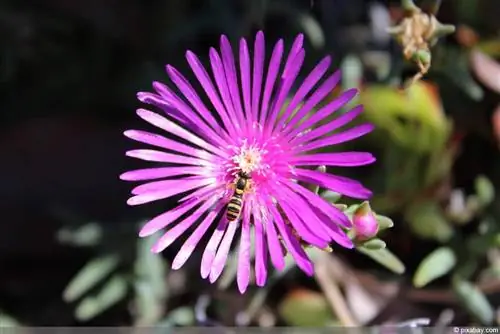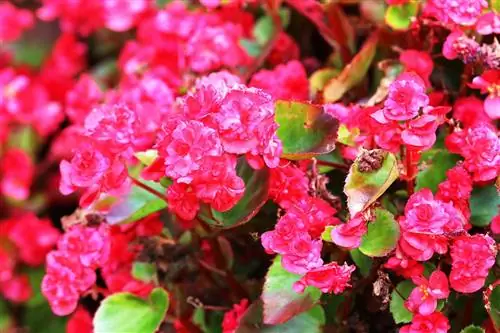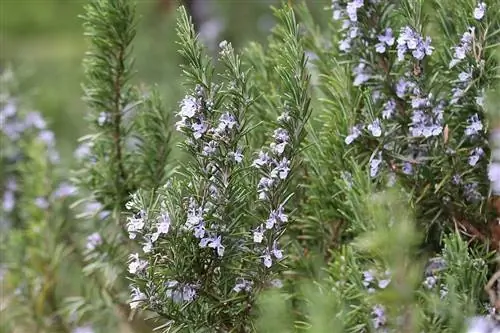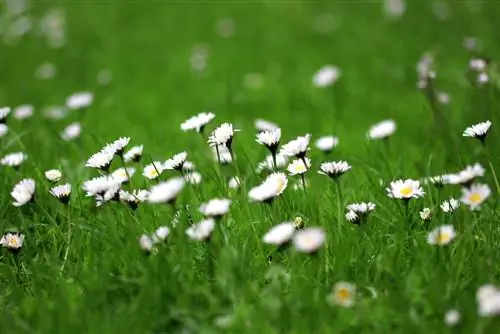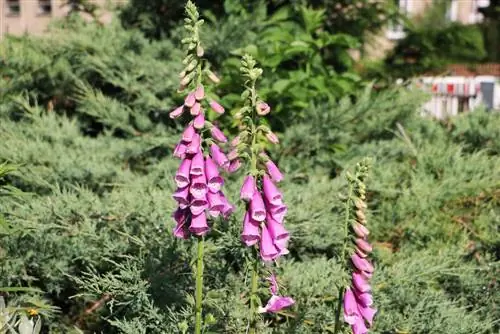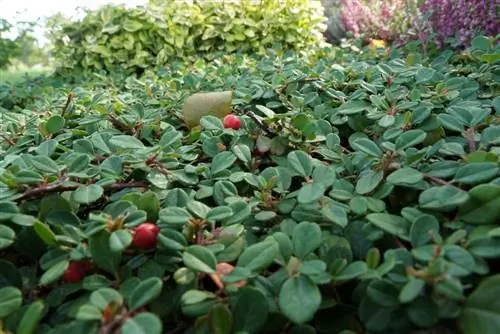- Author admin [email protected].
- Public 2023-12-17 03:39.
- Last modified 2025-01-24 12:45.
Ice flowers originally come from the warmer regions of South Africa and are also widespread in Mediterranean countries. However, some varieties have adapted to the Central European climate through breeding interventions. In terms of location and care, they are very undemanding and can easily overwinter in the bed when planted out. Ice flowers bloom colorfully and tirelessly: They look wonderful in the bed as well as in the rock garden or in the balcony box.
The best species and varieties
Typically, ice plants are not hardy. You can safely leave the following varieties outside over the winter months. If necessary, the plants only need a light winter protection made of brushwood, and they must not be too wet.
- ‘Pink Ribbon’: blooms in bright pink
- 'Hot Pink Wonder': colorful flowers, white and yellow inside with strong purple tips
- 'Fire Wonder': colorful flowers, white and yellow inside with red tips
- 'Violet Wonder': very pretty flowers, white inside with purple tips
- ‘Golden Wonder’: bright yellow flowers
- ‘White Wonder’: bright white flowers
- ‘Golden Nugget’: numerous golden yellow flowers
- 'Red Fire': large, strong red flowers
- 'Kelardis': medium-sized, salmon pink flowers
- ‘Indian Summer’: two-tone color combination, pink inside, orange-red outside
- ‘New Fire’: two-tone, violet inside, light orange outside
In addition to the varieties listed, there are numerous other winter-hardy Delosperma in different colors - from solid white to yellow, orange, red, violet and multi-colored flowers, you will find a large selection for beds and pots. By the way, all Delosperma species and varieties are valuable food plants for insects, which primarily attract bees, bumblebees and butterflies.
Tip:
Very different species are available commercially under the name “hardy ice flower”. This article deals with hardy ice plants of the genus Delosperma. So-called bed begonias are often also sold as “ice flowers”, but have completely different requirements in terms of soil and care. Be sure to pay attention to the Latin species name on the label!
Location
The ice plant owes its name to the fact that it does not dry out even in the hottest midday sun. The succulent plant therefore thrives best in a location that is as sunny and warm as possible, especially since its bright flower colors only really come into their own in a location with full sun. They still thrive in a light, partially shaded place, but then they may bloom less lushly and colorfully.
Substrate and soil
Ice flowers are survivors and thrive best in a dry, well-drained and poor substrate. Planting in normal garden soil is possible, but it should be loosened up well with fine gravel, sand or chippings. However, the hardy ice plants feel most comfortable in a stone or gravel bed. The same applies to the substrate in a pot culture: Use normal, high-quality potting soil and mix it with plenty of sand or expanded clay. Good drainage is essential!
Advance
So that you can enjoy the beautiful frost flowers in summer, you should sow them from December onwards. However, the seeds are not sown directly outdoors, but in pots on the windowsill. By the planting date, the early plants are strong enough to move into the bed or balcony box.
How to sow the hardy ice plants:
- Fill growing trays or small pots with growing substrate
- Substrate must be peat-free, if necessary thin out with sand or fine gravel
- Spread seeds on the substrate, do not cover them!
- Midday flowers are light germinators
- moisten well
- Cover the cultivation container, if possible use an indoor greenhouse
- place in a bright and warm (at least 20 °C) place
- Keep substrate slightly moist until germination
- Air the mini greenhouse regularly
The young plants are separated as soon as they have developed another pair of leaves in addition to the cotyledons.
Plants and plant spacing
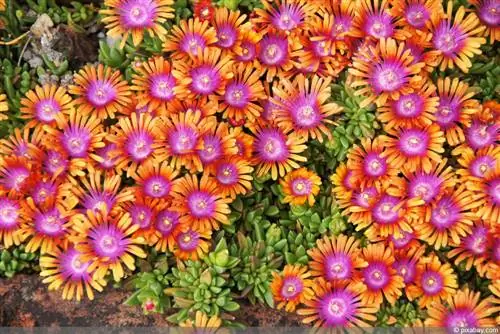
You should plant young ice flowers after the ice saints - i.e. at the end of May - when the risk of night frosts has been averted. Don't wait too long, because the longer the plants are in the bed, the better they can establish themselves, harden off and prepare for winter.
And this is how we plant:
- Weed, dig and rake the bed thoroughly
- Dig planting holes: twice as large and deep as the root ball
- ideal planting distance: between 15 and 20 centimeters
- If necessary, loosen the excavation with sand, gravel, etc.
- Introduce a drainage layer into the planting pit
- Unpot the young plants and place them in the middle of the planting pit
- Be sure to maintain the previous planting depth
- water thoroughly
Tip:
Dry stone walls can be wonderfully planted with ice flowers and other mat-forming succulents.
The most beautiful plant partners
Other succulent perennials that also form cushions are particularly suitable as companion plants. These include, for example, stonecrop, stonecrop (Sedum) or winter-hardy opuntia. Low perennials or ground covers that have similar needs in terms of location, soil and care are also suitable. When combining with taller plants, make sure that they do not shade the sun-hungry ice plants. However, Delosperma looks most beautiful when you plant different colored varieties together.
Flowering time
The typical radial flower heads appear between June and August. Hardy ice plants often form dense, bright mats and, if you regularly remove dead flowers, can bloom well into autumn.
The secret to lush blooming frost flowers is to leave them alone if possible. Do not fertilize the plants, apart from a starter fertilization consisting of compost and horn shavings in April, and also leave the watering can: the location may not be dry enough, and a gentle shower of rain from time to time is enough for the flowers. Instead, you should pay more attention to protecting Delosperma from rain - for example when the weather is rather rainy. For this purpose, you can, for example, install a plexiglass roof, which is simply removed again when the weather is nice.
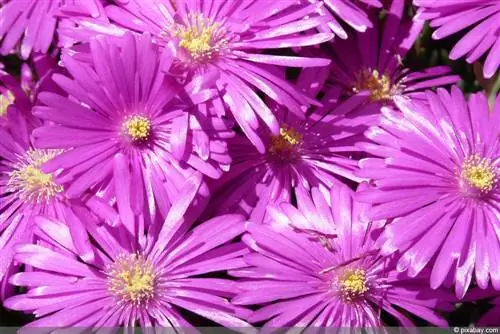
Watering and fertilizing are only occasionally necessary when growing in pots, as the plants cannot take care of themselves. However, water very sparingly and fertilize according to the manufacturer's instructions with a fertilizer for cacti and succulents.
Cutting
Ice flowers are cushion-forming, low perennials that sometimes form flat carpets. Therefore, keep a close eye on the bed and cut the plants back if they spread too much or threaten to overgrow their plant neighbors. You should also remove dead flowers with scissors to encourage the plants to bloom again. No further cutting measures are necessary.
Propagate
The easiest way to propagate is through cuttings or cuttings that you cut in early summer:
- Pluck or cut a finger-length piece from the mother plant
- A larger piece of upholstery is also suitable
- Fill the planter with potting soil or cactus soil
- Press sections lightly
- don’t water!
The new roots will form after about two to three weeks. However, you should no longer plant these specimens outdoors as they will not root in time for winter. Instead, overwinter them cold and frost-free first and put them in the bed next spring. Another propagation method is sowing, either from purchased or home-grown seeds.
To do this, collect the tiny seed capsules, open them and sow seeds immediately. However, this method is quite laborious. However, some varieties also self-seed. Larger cushions can be propagated in spring by dividing the root balls with the help of a spade. The divided pieces can then be carefully dug up and planted separately.
Diseases and pests
Ice flowers are quite insensitive to pathogens and pest infestations. Only aphids appear occasionally, but they can be driven away quite reliably with the help of nettle manure. If frost flowers don't want to grow and bloom properly, then the reason is either that the soil is too shady and/or moist. Excessive moisture causes the plant to rot and eventually die.
Wintering
Most varieties are frost-resistant up to around 20 °C, but usually require rain protection. If frost flowers do not survive the winter, it is rarely due to the cold. Most of the time the plants literally drowned. Therefore, cover the perennials with brushwood, preferably spruce and fir brushwood, straw or leaves and provide adequate protection from the rain.
Tip:
So far it has not been conclusively clarified whether Delosperma species and their varieties are poisonous or not. If you have small children or curious pets, it is best to keep them away from the colorful flowers.

